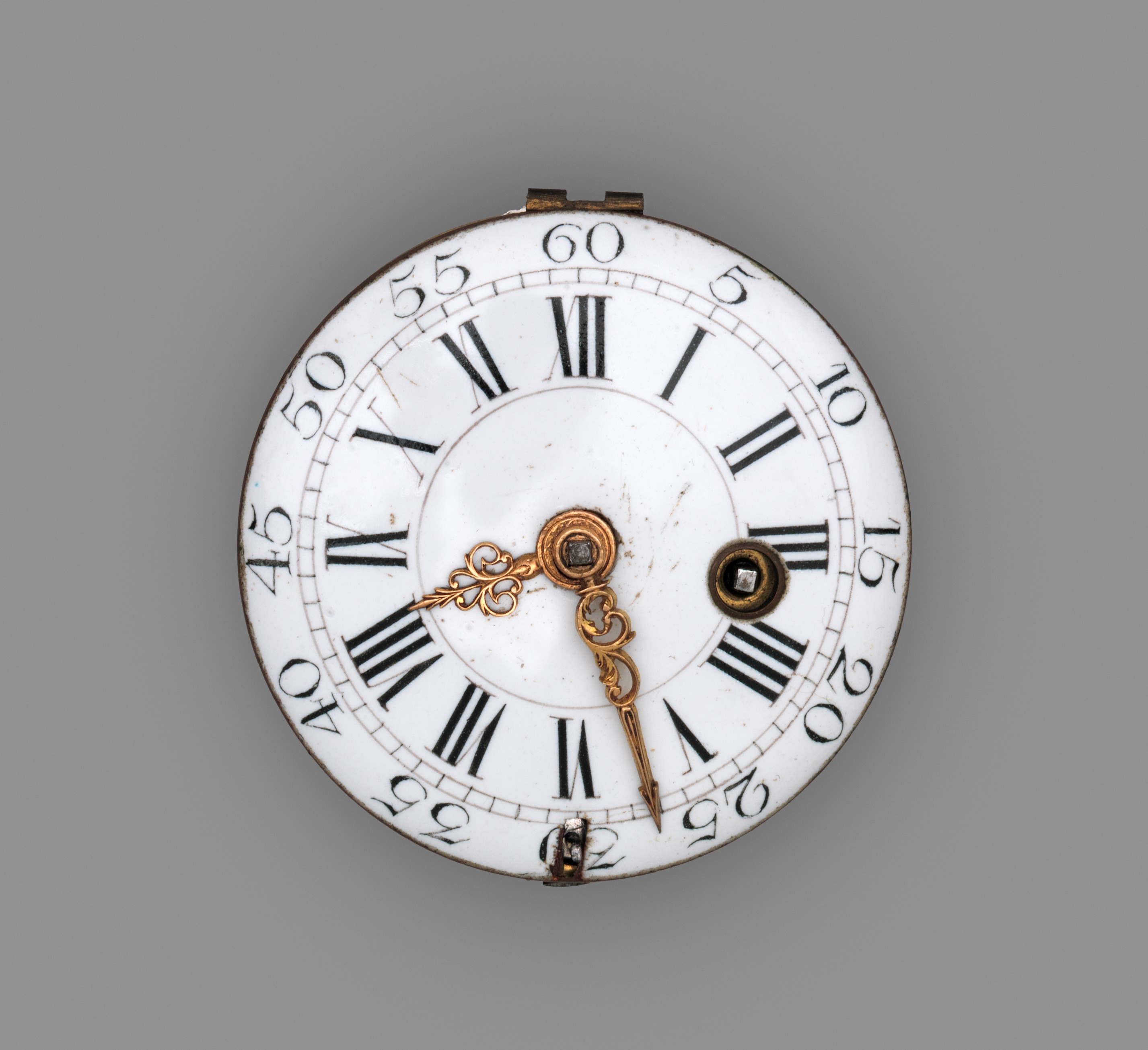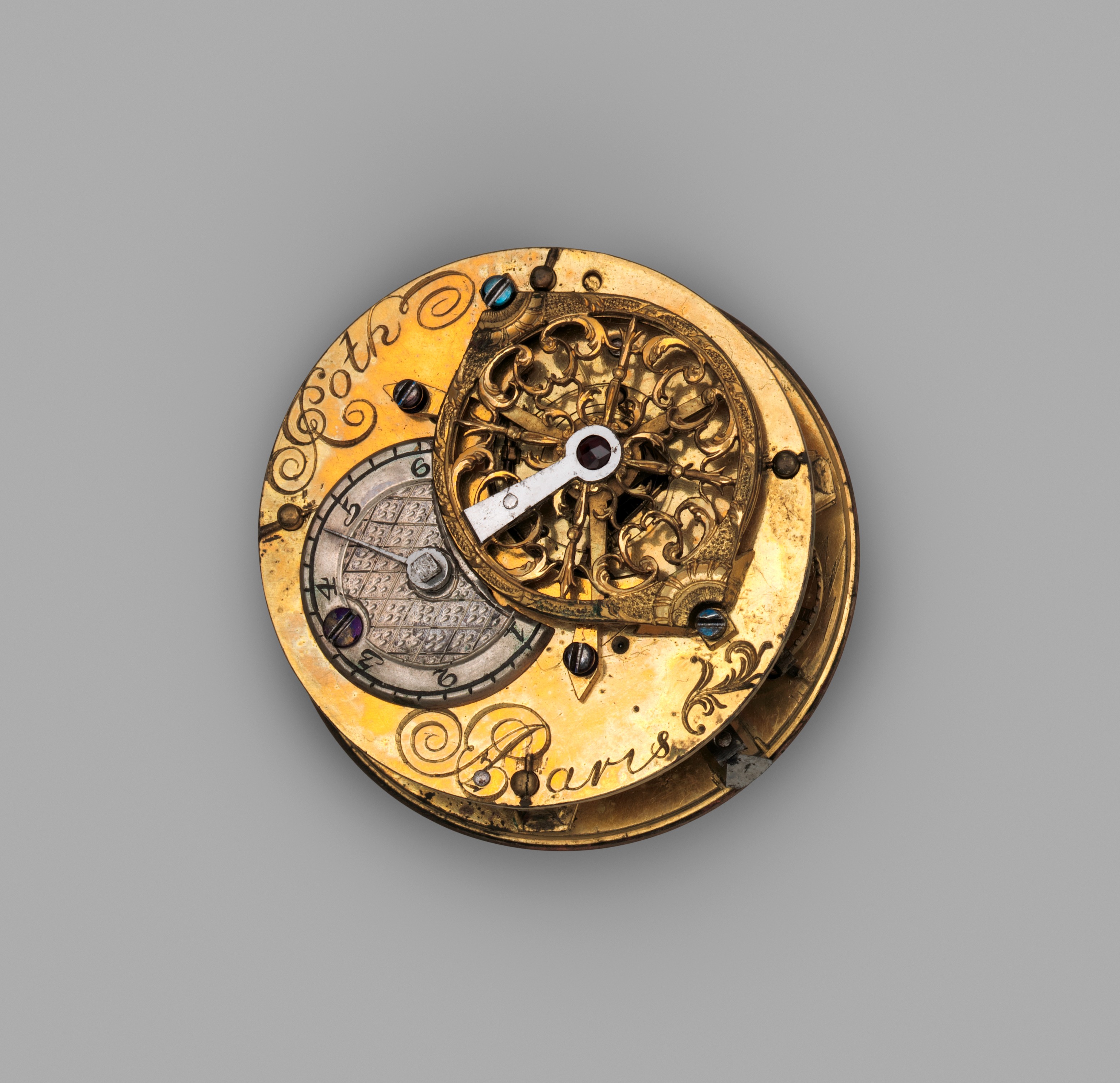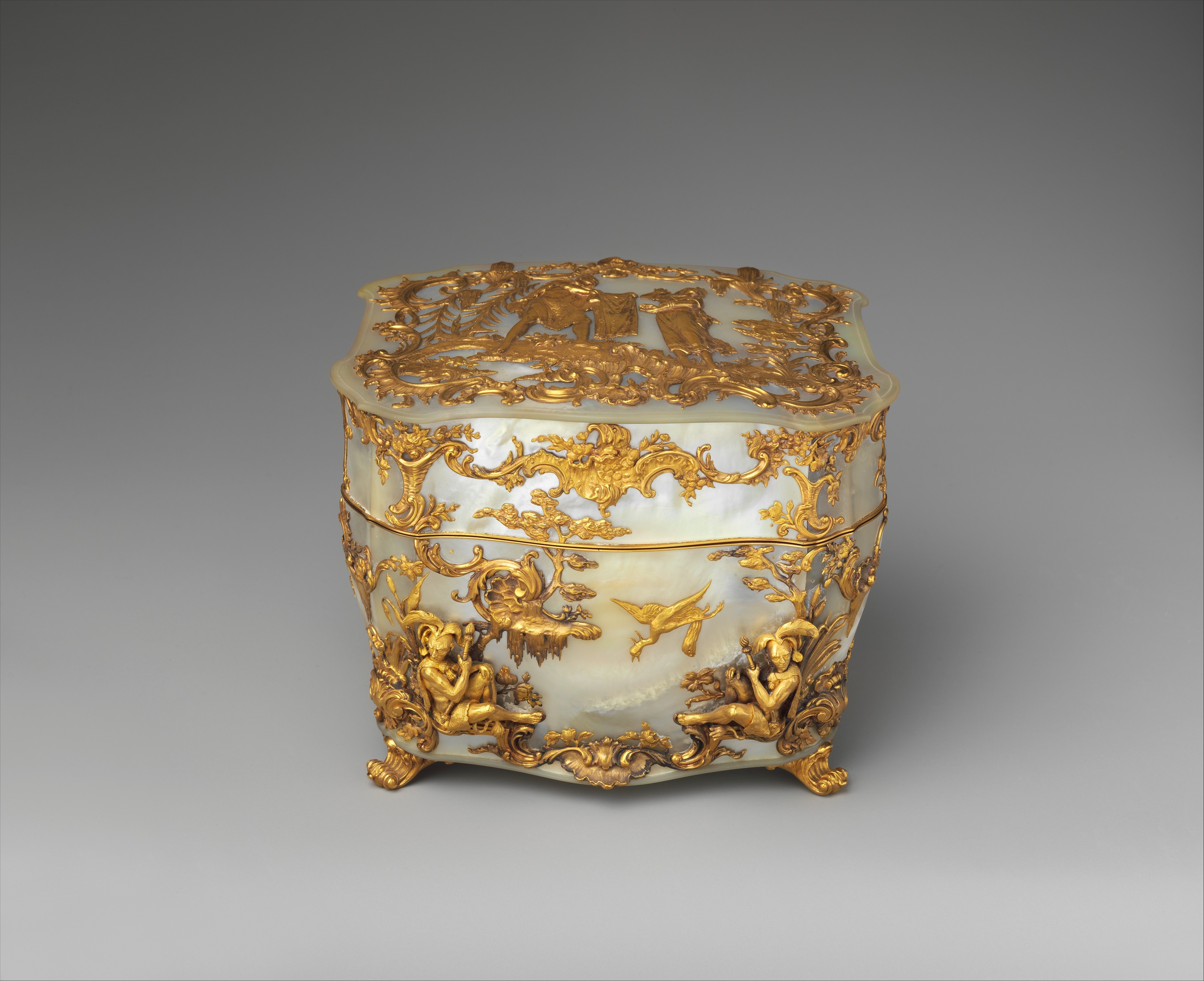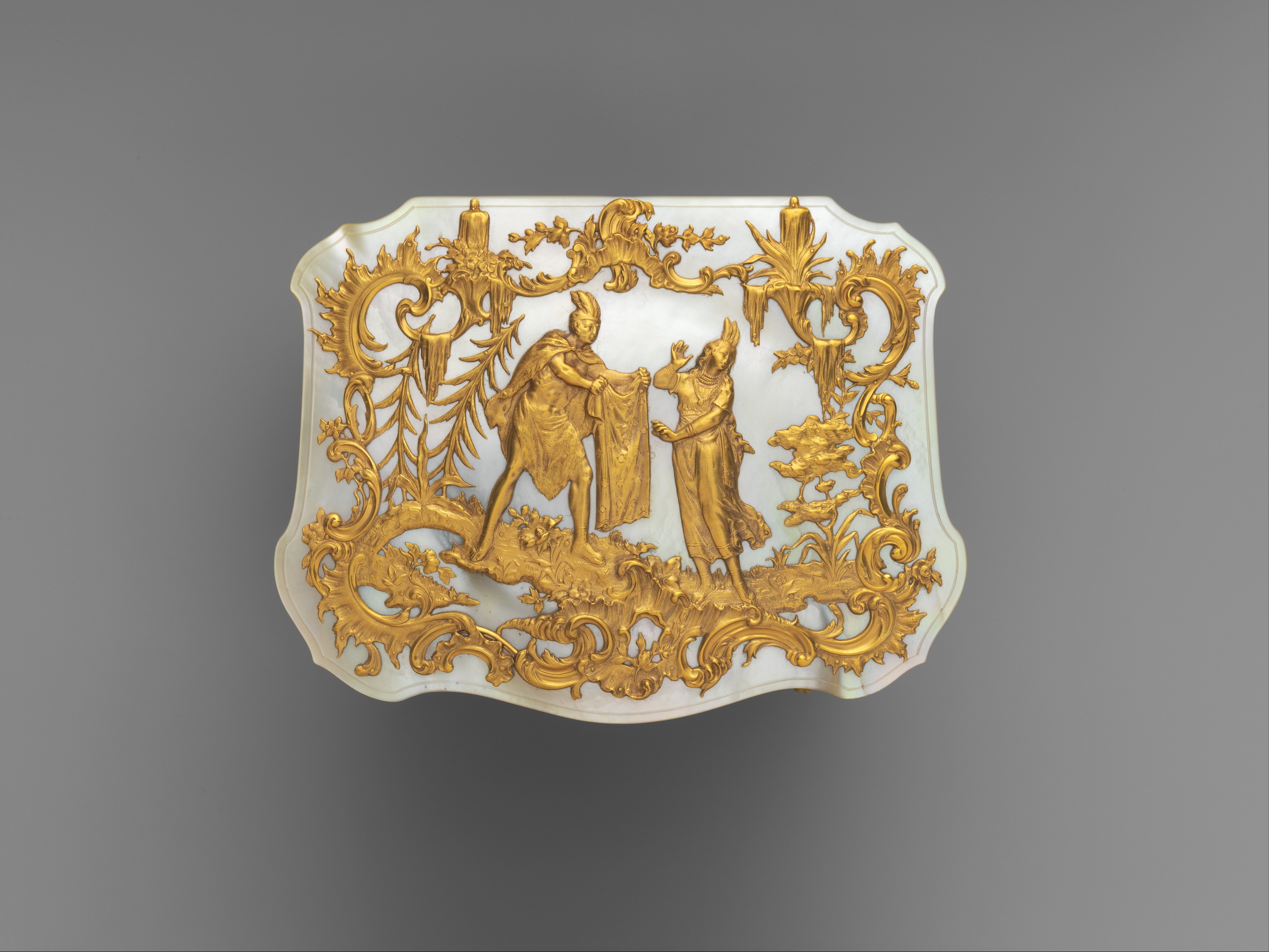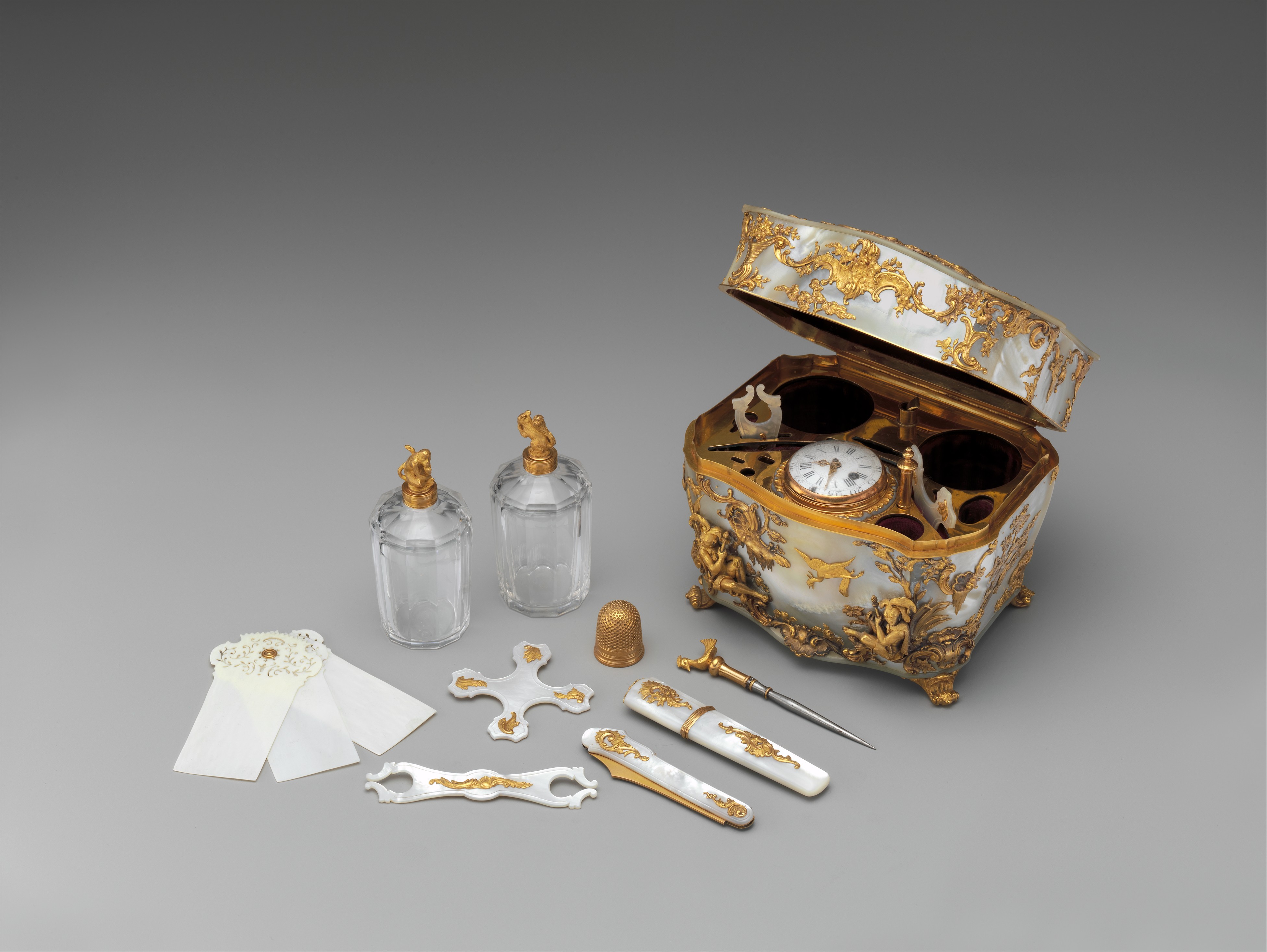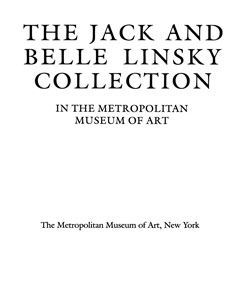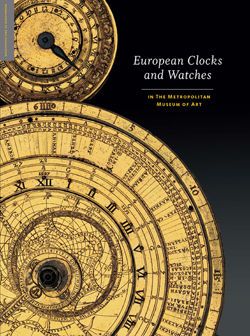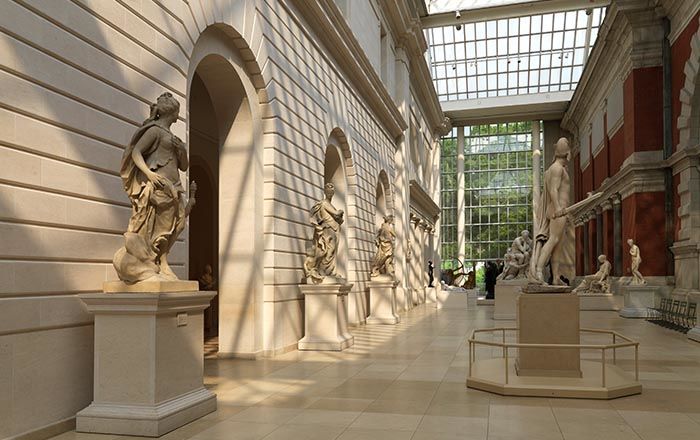Nécessaire with watch
The ornament of this exquisite nécessaire, a portable box, or casket, for the storage of small items needed in domestic life,[1] reflects the taste for chinoiserie, a European evocation of Chinese art. Chinoiserie usually incorporated figures of “Chinamen,” the Chinese of European fantasy. When combined with rococo ornament with its rocaille—exotic rockwork, with seashells of various degrees of fidelity to nature—and with the ubiquitous C-scrolls, chinoiserie remained fashionable throughout much of the eighteenth century.
The Metropolitan Museum’s nécessaire, shaped like a bombé commode, is made of gold to which sheets of white mother-of-pearl are attached by gold pins driven through artfully arranged ornaments of bright gold. It rests on four scrolled feet and has a hinged cover made of the same wonderfully lustrous materials. The sides of the casket are ornamented in high relief: a bird flies into the space between two seated human figures on the front side, a monkey sits on a tree branch on the left side, and the cover depicts a man presenting a garment to a woman who is turning away in distaste. Flaming C-scrolls, baskets of flowers, and bits of shrubbery from the vocabulary of chinoiserie ornament frame the scene on the cover, and comparable ornaments organize the space on each of the sides.
Included in a 1944 sale as the work of French goldsmith François Germain (1726–1791),[2] the nécessaire belongs to a group of caskets that use the same technique and is made from the same materials that are now thought to have been the work of an anonymous German goldsmith. Besides the Metropolitan’s example,3 there are three in the James A. de Rothschild Collection at Waddesdon Manor, near Aylesbury, Buckinghamshire, England;[4] one in the Cleveland Museum of Art;[5] and one in the Museum für Kunsthandwerk in Frankfurt am Main, where it has been related to eighteenth-century German designs for architecture and for ornament.[6] Several others are in private collections.
A closer look at the human figures on the Metropolitan’s nécessaire reveals that the two figures on the cover and the two on the front side are neither Chinese nor even fantasy Chinese, but rather American Indians, as evidenced by the fact that they all wear feathers on their heads in the approved eighteenth-century European iconography for native Americans. Should there be any further doubt, however, the two seated figures with their commanding headgear each hold long-handled clubs, and of a particular origin: they are ceremonial objects used by natives of Brazil. Helmut Nickel has traced European acquaintance with the clubs to a report by Hans Staden (ca. 1525–ca. 1576), a sixteenth-century German sailor, who was stranded for a time among the Tupinamba people in Brazil. Staden described the clubs as “used for the ritual killing of a captive enemy, who was then eaten at a festive banquet.”[7] Nickel found the particular club pictured in later German prints, such as the illustrations for the Trachtenbuch (1577) by Hans Weigel (active 1545–77), where, in addition, a Brazilian Indian man wears a cape [8] with fluffy feathers, and another wears what looks like ostrich feathers forming a sort of bustle. [9] Still later in the century, a man with the club was among the illustrations by Theodore de Bry (1528–1598) for part three of his influential Historia Americae (1590–92).[10] Nickel further recognized details from de Bry’s illustrations as models for parts of the well-known figure of the Moor with the Emerald Cluster (Mohr mit der Smaragdstufe),[11] created shortly before 1725 by the Saxon Court goldsmith Johann Melchoir Dinglinger (1664–1731) and the court sculptor Balthasar Permoser (1651–1746).[12 ]The two seated figures on the nécessaire clearly have their origins in sixteenth-century German depictions of American Indians, and the German tradition is shown to have been current as late as 1725 or 1726, or only a few years earlier than the probable date when the fierce warriors of the Tupinamba people ended up as ornaments on the sewing kit that was intended for a gnadige Frau (gracious lady).
The interior of the cover of the Metropolitan Museum’s nécessaire is fitted with a large mirror, and the box contains slots for sewing implements made of gold and mother-of-pearl, a spray of ivory leaves, a gold-tipped pencil for writing on the ivory, and two glass scent bottles with golden stoppers: one in the form of a squirrel, the other a monkey. In addition, the nécessaire features an embedded watch—the reason for including it in this volume. The dial of the watch is protected by a glass that is held in place by a hinged gold bezel. The dial is made of white enamel with painted roman numerals (I–XII) for the hours and Arabic numerals (5–60, by fives) for the minutes. It has hour and minute hands of sculptured brass and a hole between the three and four o’clock positions for winding the mainspring. The dial and movement are hinged to the interior of the casket at the twelve o’clock position, and the movement consists of two circular full plates held apart by four square-sectioned pillars. The movement also contains a train of four wheels regulated by a verge escapement. The back plate carries an openwork balance bridge, a silver figure plate for adjusting the balance spring, and the signature, “Roth AParis.” While the standard biographical dictionary of French clock- and watchmakers does list a watchmaker named “Roth” in Paris, first recorded in 1870,[13] the movement is consistent with eighteenth-century, not nineteenth-century, watchmaking practice.
The Museum has several eighteenth-century watches with signatures or place-names that do not match the style of the objects. One of them is a watch with a verge escapement in a pretty gold case inlaid with colored hardstones in a floral pattern.[14] It displays a technique usually associated with Johann Christian Neuber (1736–1808) of Dresden.[15] Christian Gottlieb Stiehl (1708–1792), who also worked in Dresden and held an appointment to Augustus the Strong, King of Poland and Elector of Saxony (1670–1733), as well as to his successor Augustus III (1696–1763), is known for comparable lapidary work. His floral designs are freer and less geometrical than Neuber’s,[16] and in the absence of a signature or maker’s mark, it is to Stiehl that the Museum’s watchcase can reasonably be attributed (17.190.1567). The movement of the watch is a typical product of about the third quarter of the eighteenth century, except that it is signed “Le Roy / AParis,” doubtlessly in the hope of benefiting from the excellent reputation of the Paris workshop of Julien Le Roy (1686–1759) and his son Pierre Le Roy (1717–1785). When compared with watches known to be products of the Le Roy workshop, the Museum’s watch has been confidently identified as not among that select group.
One clue as to why a good watchmaker might feel the need to sign his work in this way may be inferred from the comments of a German author published in 1723 in both Dresden and Leipzig. Worried about the state of the horological trade in Germany, he lamented that “important and rich people buy most of their clocks and watches in the fairs, or from art dealers, or from London, Augsburg, Geneva, and other places where there are many watchmakers, which annually causes large amounts of money to leave the country.”[17] Further on, he adds that German watchmakers ought to get organized and make proper masterpieces to insure a high quality of workmanship but
if it were to be that in spite of this some important people and rich wastrels cannot appreciate anything that does not come from France or England, then a heavy tax could be levied on such foreign clocks and watches, and in addition the accredited [German] clockmakers [could be allowed] to engrave London or Geneva on their dials. . . .[18]
Such thinking may help to explain the signature on the watch inside the Museum’s nécessaire, as well as the signature on another watch in the Metropolitan with a movement signed “Le Roy AParis” and a case attributed to Stiehl of Dresden.[19] A third watch in the Museum’s collection incorporates a minuscule automaton equestrian hunt, which is housed in a gold case with panels of mother-of-pearl overlaid by partly enameled gold trophies and figures of military gentlemen brandishing weapons (17.190.1434).[20] The dial of the watch is signed simply “London.” In all probability, the three watches are German. There are empty slots in the interior of the nécessaire, which suggests that a few of the implements are now missing. Otherwise, the object is in remarkably good condition. There are almost no signs that it was actually ever used. The nécessaire comes from the collection of J. Pierpont Morgan,[21] through the generosity of Jack and Belle Linsky.22 It is not known where Morgan acquired the nécessaire.
Notes (For key to shortened references see bibliography in Vincent and Leopold, European Clocks and Watches in the Metropolitan Museum of Art. NY: The Metropolitan Museum of Art, 2015)
[1] For an overview of the purpose of this necessaire and comparable objects, see Kisluk-Grosheide 2011.
[2] Parke-Bernet Galleries 1944, p. 152, no. 607, ill. p. 153.
[3] See Clare Le Corbeiller in Metropolitan Museum of Art 1984, p. 190, no. 110. Le Corbeiller noted similarities of the ornament to designs by Francois Cuvillies (1695–1768) working in Munich.
[4] Serge Grandjean in Grandjean et al. 1975, pp. 94–102, nos. 45–47.
[5] Acc. no. 67.157.
[6] Inv. no. 12056. See Heidrun Zinnkann in Museum fur Kunsthandwerk 1987, pp. 94–95. For an example of ornament by Johann Michael Hoppenhaupt II, see Maurice 1976, vol. 1, pp. 238–39.
[7] Staden 1557, quoted in Nickel 2002, pp. 87–88; see also p. 87, fig. 9, for a woodcut depicting a long-handled club published in Staden’s 1557 account.
[8] Published by Weigel in Nurnberg in 1577. See Nickel 2002, p. 84, and p. 85, fig. 4.
[9] Nickel 2002, pp. 84, 86, and p. 85, fig. 5.
[10] A multivolume work published in Frankfurt am Main; part three, published in 1592, was titled Americae Tertia Pars: Memorabile[m] Provinciae Brasiliae Historiam. See Nickel 2002, pp. 87–88, and fig. 10. See also entry 48 in this volume.
[11] In the collection of the Grunes Gewolbe in Dresden, inv. no. viii 303. See Nickel 1980, p. 204, figs. 1, 2.
[12] For the de Bry illustrations, see Nickel 1980, pp. 207–8, 210, and figs. 9, 10.
[13] Tardy 1971–72, vol. 2, p. 572.
[14] Acc. no. 17.190.1567.
[15] For a scholarly appraisal of Neuber’s work in inlaid hardstones by various authors, see Gold, Jasper and Carnelian 2012.
[16] Somers Cocks and Truman 1984, pp. 282–83, no. 98. See also Poindront and Kugel 2012, pp. 223–25.
[17] Marperger 1723, p. 152 (translation by J. H. Leopold).
[18] Ibid., p. 154 (translation by Leopold).
[19] Acc. no. 17.190.1586.
[20] Acc. no. 17.190.1434.
[21] Williamson 1910, pp. 151–52, no. 108, and pl. 45.
[22] Le Corbeiller in Metropolitan Museum of Art 1984, p. 190, no. 110.
This image cannot be enlarged, viewed at full screen, or downloaded.
This artwork is meant to be viewed from right to left. Scroll left to view more.



